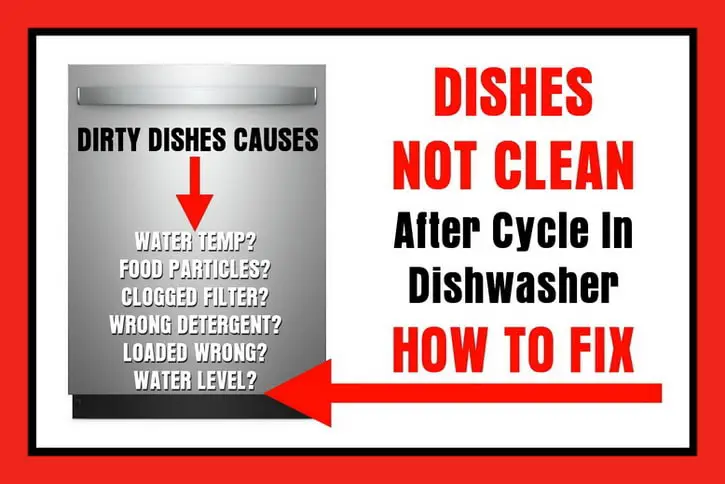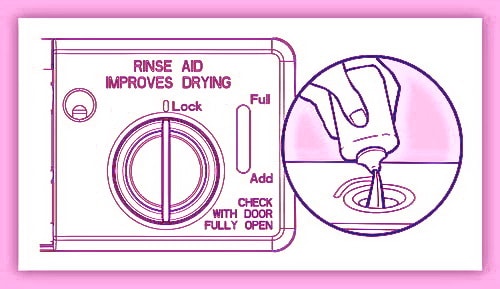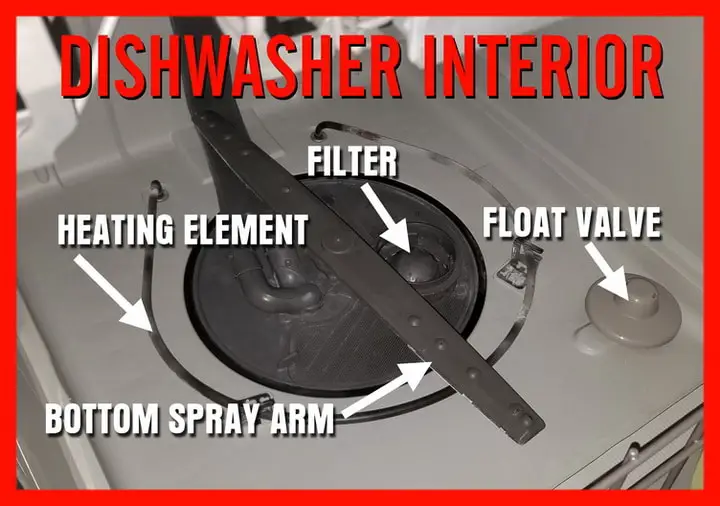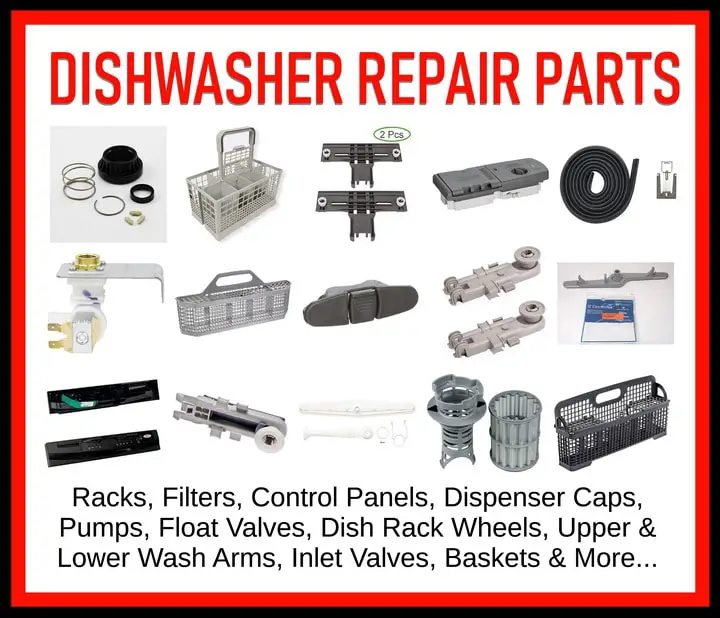How do I get my dishwasher to clean better? After washing my dishes in my dishwasher, the dishes have food particles and white film on them. At times the detergent is not fully dispensed. What can I do to remedy the problem of dirty dishes after washing in the dishwasher?
 Dishes Not Clean After Washing In Dishwasher
Dishes Not Clean After Washing In Dishwasher
Food particles, white film, and detergent not being properly dispensed is a problem with many dishwashers. Here are 10 helpful hints and tips to get cleaner dishes when using your dishwasher.
Dishwasher not cleaning dishes properly
The 10 things that can cause your dishwasher dishes to have gunk and white residue on them is below. Some of the things concern the dishwasher itself, and others relate to how the dishes are placed in the dishwasher or what type of detergent is used. Try all 10 of these methods to get your dishwasher running properly. If you encounter any problems, leave us your question below and we can help.
1. FOOD PARTICLES
Large food particles on dishes in the dishwasher can be a problem. Scrape or wash off large food particles before putting them in the dishwasher. Large chunks of food can clog up the dishwasher and reduce cleaning performance. Most dishwashers have the capability to grind through food chunks. However the dishwasher will perform much better if the dishes are free of food particles.
2. DISHWASHER LOADED IMPROPERLY
If the dishwasher is loaded with dishes in a non symmetrical pattern, the dishwasher will not be able to clean the dishes correctly. Do not load the dishwasher in a strange pattern. Keep the plates and dishes in a parallel pattern so when the water sprays, the dishes are getting hit with water ad the water can flow past. If the dishes are laying flat, the water spraying cannot reach past them as the plate or dish is blocking the water.
3. TYPE OF DETERGENT
Depending on where you live, the type of detergent you use in your dishwasher matters. In most cases, a liquid or gel detergent is best as it can quickly dissolve verses powdered detergent. If you live in an area with hard water, it will be more difficult for the dishwasher to dissolve certain types of detergent. Using excessive or not enough detergent can cause issues with your dishwasher and leave a white film on all dishes and glasses. Read the user’s manual for your dishwasher to see what the manufacturer recommends. Dishwasher PDF user manual here. GE Dishwasher Manuals – Whirlpool Dishwasher Manuals – Bosch Dishwasher Manuals
HINT: Always use a rinse aid as Cascade or Jet Dry will reduce hard water from sticking and building up on dishes and cups.
 Dishwasher with rinse aid will clean better
Dishwasher with rinse aid will clean better
4. DISHWASHER INTERIOR
Be sure to keep the interior of the dishwasher clean. This is to remove any food particles, pieces of broken dishes, cups, or any build up that should not be in the dishwasher. Hard water can build up in the dishwasher and cause problems. Clean the top rack, bottom rack, sides, and the bottom of the dishwasher to remove all gunk. It is recommended to clean out the dishwasher after the 25th wash cycle.
5. CLOGGED FILTER(S)
Many dishwashers have a filter in the bottom. This filter can become blocked and reduce performance of the dishwasher. Clean the filter at the inside bottom of the dishwasher. Remove it by unscrewing it from the dishwasher housing. Run the filter under hot water to clean it. Also check in the housing where the filter sits in the dishwasher for more debris. Clean it out and be sure to remove all gunk and debris. Screw the dishwasher filter back in and be sure it is securely fitted into the dishwasher housing. HOW TO CLEAN WHIRLPOOL DISHWASHER FILTERS – See picture below to understand location of components…
 Dishwasher interior parts – Element, filter, float, spray arm
Dishwasher interior parts – Element, filter, float, spray arm
6. WATER LEVEL ISSUES
If the dishwasher is not getting enough water, the dishwasher will not be able to clean properly. Run a test wash, open the door after the water fills and be sure the water reaches the heating element. If not check the following parts. The float valve in the dishwasher controls how much water flows into the dishwasher. Check the float valve in the bottom of the dishwasher to be sure it moves freely. WATER LEVEL IN DISHWASHER – See picture above to understand location of components…
7. WATER TEMPERATURE
If the water going into the dishwasher is not hot enough, the dishwasher may not be able to clean the dishes properly. If you suspect your dishwasher is not getting hot water, check the water temperature. Run hot water from the nearest sink. Put the water into a bowl or glass and test it with a thermometer. Be sure the water is within the range from 120F to 140F for proper operation. You can also try running the hot water at the sink closest to the dishwasher. Run the water until hot, then run the dishwasher. HOW TO SET WATER TEMP ON WATER HEATER
8. INLET SCREEN BLOCKED
If the inlet screen in the dishwasher is clogged or blocked, it may cause the dishwasher to not clean the dishes or leave food particles. You can attempt to clean the inlet screen and remove all food particles or gunk clogging it. If this screen is damaged from cleaning, the problem will elevate. Use caution when cleaning the inlet screen. It is best to replace the inlet screen if is found to be clogged.
9. WATER VALVE ISSUES
Another part in your dishwasher to check is the water inlet valve. The water inlet valve opens to allow water to flow into the dishwasher. If faulty, the water may not flow properly. When this part goes bad, you may hear a hammering noise. This hammering noise is a sign that the water inlet valve is going bad. Replace it if you hear the hammering noise. A bad water inlet valve may not fill the dishwasher with water properly, therefore leaving gunk on the dishes after a wash cycle. DISHWASHER NOT FILLING WITH WATER
10. SPRAY ARMS CLOGGED/STUCK
If hard water is an issue in your area, the upper or lower spray arms in the dishwasher that spray water may be so badly clogged that the spray arms are not able to spray water onto the dishes properly. To remedy this issue, simply use something like a toothpick or similar and make sure the water spray holes on the spray arms are not blocked. If you find the spray arm damaged, replacing it is easy. If the spray arm is stuck and unable to freely move, this can also hinder how the dishes are cleaned. Make sure the spray arms are not blocked or a dish is not hitting the arm causing so it cannot move. DISHWASHER SPRAY ARM ISSUES
 Dishwasher Control Panel – Heavy, Normal, Sensor, Soak & Clean
Dishwasher Control Panel – Heavy, Normal, Sensor, Soak & Clean
WHAT WASH CYCLE IS BEST FOR A DISHWASHER?
Heavy – Best setting for difficult items like pots or pans
Sensor – Dishes will be cleaned using minimal water and energy usage
Normal – Perfect for normal use such as dishes and cups
Auto – Dishes will be cleaned using minimal water and energy usage
TIP: Always use a rinse aid to assist the dishwasher – Cascade or Jet Dry reduces hard water from building up on dishes
 Dishwasher Replacement Parts
Dishwasher Replacement Parts
Racks, Filters, Control Panels, Dispenser Caps,
Pumps, Float Valves, Dish Rack Wheels,
Upper & Lower Wash Arms, Inlet Valves, & Baskets.
NOTE: All dishwasher troubleshooting methods above will work on all GE, Whirlpool, Samsung, LG, Haier, Kenmore, Hotpoint, Emerson, Maytag, Sharp, Bosch, KitchenAid, and Frigidaire dishwashers.
MORE DISHWASHER HELP – LEAKING, DRAINING, TOO LONG, FILLING
How To Fix A Dishwasher That Is Not Draining
Dishwasher Not Spraying Water – How To Repair
How To Fix A Dishwasher That Tips Forward When Opened
Dishwasher Cycle Takes Too Long To Finish Cleaning
Dishwasher Turns On And Starts By Itself – Causes and Solutions?
Water Coming Into Dishwasher When Off – Dishwasher Fills With Water – How To Fix It
Dishwasher Is Leaking Water From The Door – How To Fix?
Need tips to fix your dishwasher from white residue and food particles? Let us know your dishwasher issue below by filling out the form below with your model number and the problem you are having.



I have a Frigidaire dishwasher and it’s beeping is a constant aggravation. I have to reset the machine to stop beeping. Is there a way to permanently stop beeping? – i.e. disconnect feature?
I have 2 identical Kitchenaid dishwashers (KDTE104ESS1), one on each side of the sink, in a 3 year old house. A couple of months ago, they both had the same issue start at the same time – water does not spray around in the tub. When we start a load, we hear the sounds of everything happening like normal except for the water. No water is spraying around. After about 10-20 minutes of starting it, we open the door and there is water sitting in the bottom of the tub up to the level of the heating element, but it is obvious no water has been sprayed around because none of the dishes are wet. This happens about 4 out of 5 times we start a load, but occasionally it will work like normal. We have gone through the troubleshooting procedures on the control panel (we have the service person’s paper and followed those instructions) and there is no trouble code. About a month ago, my husband pulled both of the dishwashers out, turned them on their backs, examined some parts to check for clogs, etc, and put them back together and now the left dishwasher works perfectly but the right one still has the problem. He replaced the water inlet valve on the right one a few days ago, but it didn’t make any difference. In answer to the suggestions above on what to do: The float goes up and down just fine, we have always cleaned the filter on a regular basis, we have a water softener so we don’t have hard water, our water gets plenty hot, we refill the rinse-aid dispenser often, we have cleaned the dishwasher recently with vinegar solutions and with special dishwasher cleaner, the spray arms aren’t clogged because they spray fine when the load actually runs.